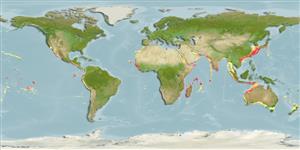Common names from other countries
Environment: milieu / climate zone / depth range / distribution range
Ökologie
seewasser riff-verbunden; tiefenbereich 50 - 300 m (Ref. 28016). Subtropical; 35°N - 50°S, 32°E - 5°W
Southeast Atlantic: St. Helena and Ascension islands (Ref. 7097). Western Indian Ocean: southern Red Sea, off Oman and Sri Lanka. Eastern Pacific: Hawaiian and Revillagigedo islands (Ref. 9283). Reported from the Arafura Sea (Ref. 9819) and Persian Gulf (Ref. 68964).
Size / Gewicht / Alter
Maturity: Lm ? range ? - ? cm
Max length : 58.0 cm TL Männchen/unbestimmt; (Ref. 55763); common length : 35.0 cm TL Männchen/unbestimmt; (Ref. 55763)
Rückenflossenstacheln (insgesamt): 9; Rückenflossenweichstrahlen (insgesamt): 25-30; Afterflossenstacheln 3; Afterflossenweichstrahlen: 19 - 22.
Adults are benthopelagic in sandy bottoms at the foot of the edge of the outer reefs, continental coasts and around islands (Ref. 9283). Solitary or forming small schools (Ref. 30573). Mainly nocturnal (Ref. 4887). Marketed fresh and salted or dried (Ref. 9283).
Life cycle and mating behavior
Geschlechtsreife | Fortpflanzung | Ablaichen | Eier | Fecundity | Larven
Smith-Vaniz, W.F., 1984. Carangidae. In W. Fischer and G. Bianchi (eds.) FAO species identification sheets for fishery purposes. Western Indian Ocean fishing area 51. Vol. 1. [pag. var.]. FAO, Rome. (Ref. 3287)
IUCN Rote Liste Status (Ref. 130435)
CITES (Ref. 128078)
Not Evaluated
Bedrohung für Menschen
Harmless
Nutzung durch Menschen
Fischereien: weniger kommerziell; Sportfisch: ja
Mehr Information
NamenSynonymeMetabolismusRäuberÖkotoxikologieFortpflanzungGeschlechtsreifeAblaichenFecundityEierEientwicklung
ReferenzenAquakulturAquakultur ProfilZuchtlinienGenetikElectrophoresesVererbbarkeitKrankheitenVerarbeitungMass conversion
Tools
Zusatzinformationen
Download XML
Internet Quellen
Estimates based on models
Preferred temperature (Ref.
115969): 14.5 - 26.8, mean 20.2 (based on 410 cells).
Phylogenetic diversity index (Ref.
82804): PD
50 = 0.6250 [Uniqueness, from 0.5 = low to 2.0 = high].
Bayesian length-weight: a=0.01445 (0.00841 - 0.02484), b=2.94 (2.80 - 3.08), in cm Total Length, based on LWR estimates for this species & (Sub)family-body (Ref.
93245).
Trophic level (Ref.
69278): 3.8 ±0.58 se; based on food items.
Widerstandsfähigkeit (Ref.
120179): mittel, Verdopplung der Population dauert 1,4 - 4,4 Jahre. (Preliminary K or Fecundity.).
Fishing Vulnerability (Ref.
59153): Moderate vulnerability (43 of 100).
